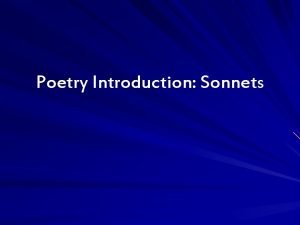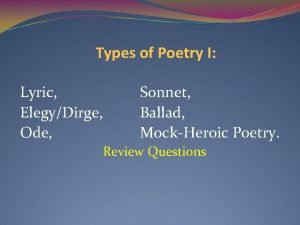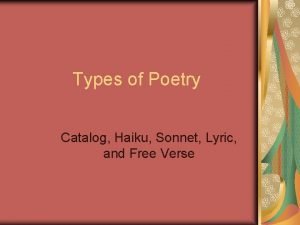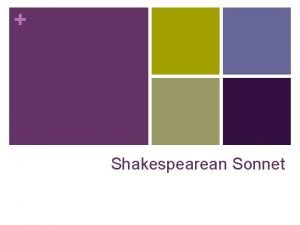The Italian or Petrarchan Sonnet Writing of Poetry







- Slides: 7

The Italian or Petrarchan Sonnet Writing of Poetry Mini-lesson #5

Origin of the Italian Sonnet • Sonnet comes from the Italian word • • • “sonetto” which means “little song. ” Francesco Petrarca, a 13 th century Italian Renaissance poet, created the 1 st form of sonnets. The Italian sonnet is also called Petrarchan His “Il Canzoniere” inspired English writers to adopt this style of writing. He taught Sir Thomas Wyatt, a famous English sonneteer, the form. Italian sonnets are full of love and passion.

The Inspiration • Italian Renaissance: a period of • • rebirth where classical art, literature, architecture and learning. Women are seen as unattainable and virtuous beauties. Platonic love (friendly or unrequited love from Plato’s philosophy of three different loves) Love and passion were big themes and inspiration for art. Petrarca fell in love with Laura who did not requite his feelings; discussed his love for her.

Structure of the Italian Sonnet • 14 line poem • Divided into two stanzas • 1 st stanza is an octave (a • • stanza of 8 lines) Octave rhyme scheme: ABBA 2 nd stanza is a sestet (a stanza of 6 lines) Sestet rhyme scheme: CDECDE or CDCDEE The turn must occur between the octave and the sestet.

Problem, Turn, and Resolution • The octave or 1 st stanza presents the reader • • about a problem or argument. The sestet or 2 nd stanza offers a solution to deal with the problem. 8 th or 9 th line is where the “volta” or turn occurs. The turn makes a shift from the problem to the solution. Problem or argument deals with love/passion.

Syllabification • All sonnets are written in iambic pentameter. • Iambic pentameter is a rhythm/meter which has • • five feet. Iamb refers to the beat that has an unstressed and stressed syllable/sound. A “foot” is the combination of a unstressed and stressed syllable (always in that order) “Penta” is five (line has five “feet”). Total of 10 syllables per line.

The Sound of Iambic Pentameter “Not like the brazen giant of Greek fame” No underline: unstressed Underlined: stressed How many syllables? Where do you hear the stress?












